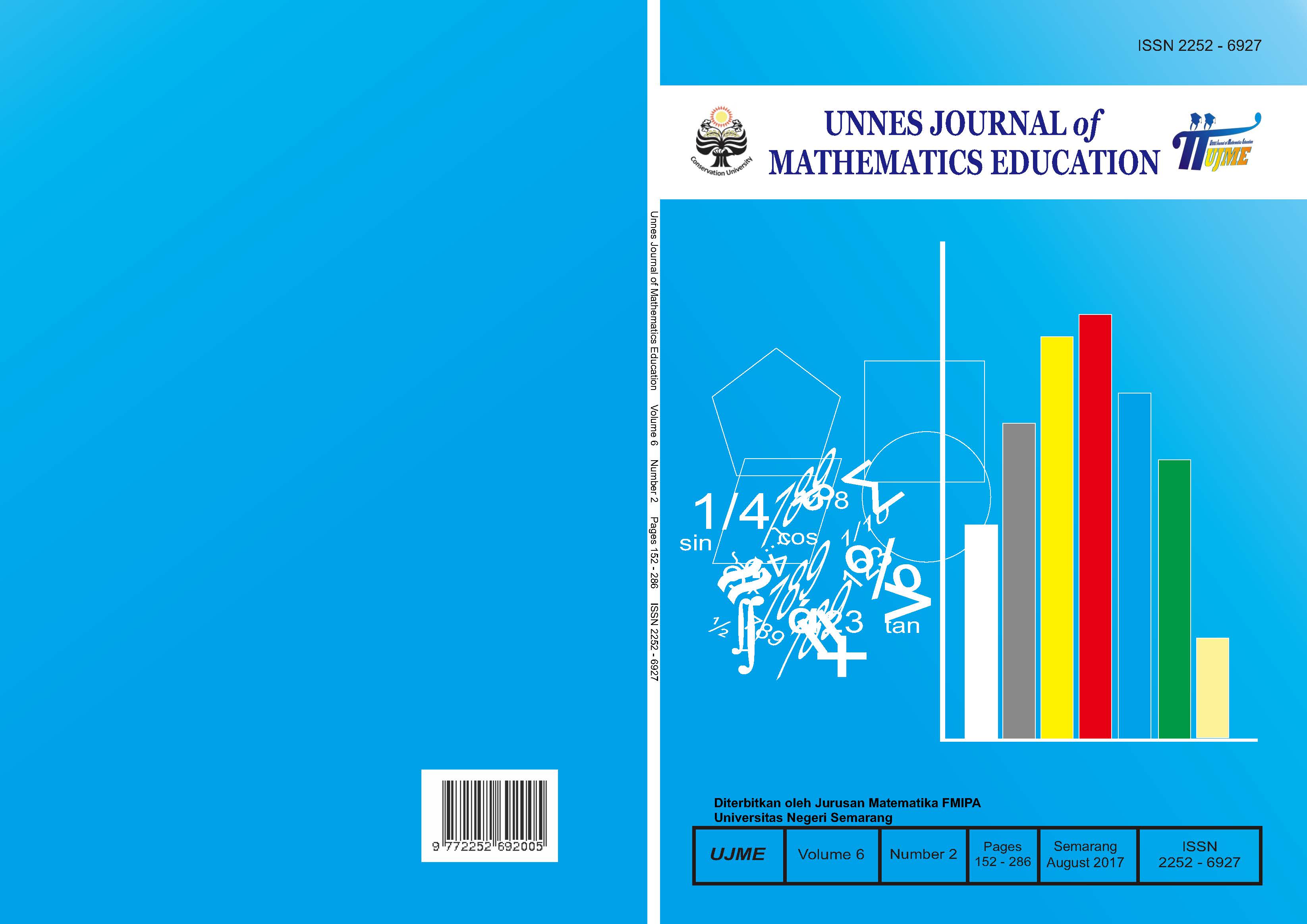Effectiveness of Probing-prompting Learning Models with Scaffolding Strategy to Mathematic Creative Thinking Ability and Enthusiasm
##plugins.themes.academic_pro.article.main##
Abstract
The purpose of this research was to know that the learning model ProbingPrompting with Scaffolding strategy effective on the mathematic creative thinking ability and enthusiasm. Based on the research results in students population in class VII SMP N 1 Adiwerna in the academic year 2016/2017, used techunique random sampling there are class VII A as experimental class and class VII B as control class. The research total show that in experimental class is reached out classical. The difference test of two average mathematic creative thinking abilities indicates that students' mathematic creative thinking ability in the experimental class is better than the control class. The difference test of two average of enthusiasm shows that enthusiasm students in the experimental class is better than the control class. The conclusion of this research is ProbingPrompting learning model with scaffolding strategy effective to the mathematic creative thinking ability and enthusiasm.
##plugins.themes.academic_pro.article.details##
References
Bikmaz, F. H., Celebi, O., & Ata, A. (2010). Scaffolding Strategies Applied by Student Teachers to Teach Mathematics. The International Journal of Research in Teacher Education, 1 (special issue): 25-36. Tersedia di http://dergipark.ulakbim.gov.tr/ijrte/article/download/5000041450/500003890 [diakses tanggal 10 Februari 2017]
Depdiknas. (2007). Model-model Pembelajaran Matematika dan Ilmu Pengetahuan Alam. Jakarta: Direktorat Pembinaan Pendidikan Luar Biasa.
Huda, M. (2013). Model-Model Pengajaran dan Pembelajaran. Yogyakarta: Pustaka Pelajar.
Kemendiknas. (2011). Pendidikan Nilai-nilai Budaya Dan Karakter Bangsa Dalam Pembelajaran Matematika di SMP. Yogyakarta: Pusat Pengembangan dan Pemberdayaan Pendidik dan Tenaga Kependidikan (PPPPTK) Matematika.
Mamin, R. (2008). Penerapan Metode Pembelajaran Scaffolding Pada Pokok Bahsan Sistem Periodik Unsur. Jurnal Chemica, 10(2): 55-60.
Munandar, U. (2014). Pengembangan Kreativitas Anak Berbakat. Jakarta: Rineka Cipta.
Peraturan Menteri Pendidikan dan Kebudayaan Republik Indonesia Nomor 61 Tahun 2014 Tentang Implementasi Kurikulum.
Prasetiyo, A. D. & Mubarokah, L. (2014). Berpikir Kreatif Siswa Dalam Penerapan Model Pembelajaran Berdasarkan Masalah Matematika. Jurnal Pendidikan Matematika STKIP PGRI Sidoarjo, 2(1): 9-18. ISSN: 2337-8166.
Rifa’i, A. & Anni, A. T. (2012). Psikologi Pendidikan. Semarang: Pusat Pengembangan MKU-MKDK UNNES.
Sanjaya, W. (2006). Strategi Pembelajarn Berorientasi Standar Proses Pendidikan. Jakarta: Kencana Prenadamedia Group.
Santoso, F. G. (2011). Mengasah Kemampuan Berpikir Kreatif dan Rasa Ingin Tahu Melalui Pembelajaran Matematika dengan Berbasis Masalah. Seminar Nasional Matematika dan Pendidikan Matematika. Yogyakarta.
Sugiyanti & Utami, R, E. (2015). Scaffolding untuk Meningkatkan Kemampuan Berpikir Kreatif Siswa Kelas VIII di SMP Negeri 15 Semarang. Prosiding Seminar Nasional Matematika dan Pendidikan Matematika UMS. Semarang.
Sugiyono. (2015). Metode Penelitian Pendidikan. Bandung: Alfabeta.
Suharsono. (2015). Meningkatkan Kemampuan Pemahaman dan Disposisi Matematik Siswa SMA Menggunakan Teknik Probing-Prompting. Jurnal Ilmu Pendidikan dan Pengajaran, 2(3): 278-289.
Suyatno. (2009). Menjelajah Pembelajaran Inovatif. Sidoarjo: Masmedia Buana Pustaka.
Swarjawa, E. (2013). Pengaruh Model Pembelajaran Probing-Prompting terhadap Hasil Belajar IPA Siswa Kelas V Di SD Negeri 1 Sebatu. Jurusan Pendidikan Guru Sekolah Dasar FIP Universitas Pendidikan Ganesha Singaraja. Tersedia di http://ejournal.undiksha.ac.id/index.php/JJPGSD/article/viewFile/825/698 [diakses tanggal 14 Februari 2017]
Trianto. (2007). Model-model Pembelajarn Inovatif Berorientasi Konstruktivistik. Jakarta: Prestasi Pustaka.
Ulya, H., Masrukan, & Kartono. (2012). Keefektifan Penerapan Model Pembelajaran Kooperatif Tipe Probing-Prompting dengan Penilaian Produk. Unnes Journal of Mathematics Education, 1(1): 27-31.
